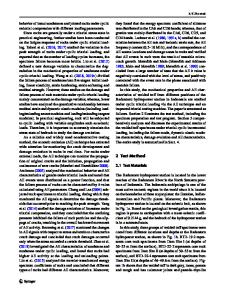Uniaxial compression creep and acoustic emission characteristics of sandstone under loading-unloading paths
- PDF / 1,399,529 Bytes
- 11 Pages / 595.276 x 790.866 pts Page_size
- 105 Downloads / 368 Views
ORIGINAL PAPER
Uniaxial compression creep and acoustic emission characteristics of sandstone under loading-unloading paths Kui Zhao 1 & Liangxiao Xiong 2,3 & Yangdong Xu 1 & Zhongyuan Xu 4 & Peng Zeng 1 Received: 10 November 2019 / Accepted: 10 November 2020 / Published online: 20 November 2020 # Saudi Society for Geosciences 2020
Abstract Specimens of red sandstone are subjected to creep and acoustic emission (AE) tests under only multi-level loading and multilevel loading-unloading. Creep deformation characteristics and AE parameters of the red sandstone specimens under these two loading paths are compared and analyzed, and a creep AE damage-variable model is used for the damage evolution of the microcracked structures inside the rock during the creep process. The research results reveal the following: (1) During the creep process involving multi-level loading-unloading, the temporal variation of the AE amplitude is similar to that observed during the creep process involving only multi-level loading. (2) The variations of the cumulative AE event and cumulative AE ring-down count in the creep process involving multi-level loading-unloading are similar to those in the creep process involving only multi-level loading, while the actual values are higher in the former process. (3) The creep AE damage-variable model performs well on characterizing the damage evolution of the internal micro-crack structure of the rock in both creep processes. Keywords Red sandstone . Uniaxial compression-creep test . Multi-level loading-unloading . Acoustic emission characteristics . Damage variable
Introduction Rock creep indicates the deformation characteristics of rock under constant load, and it is different from rock characteristics under static loading and dynamic loading (Kong et al. 2020). Creep significantly affects the stability of engineering rock masses. Many experimental studies investigated the compressioncreep properties of rock, and most researchers used multi-level loading when conducting such tests. However, the excavation
and support can either increase or decrease the stress in the surrounding rock during underground engineering. Therefore, in compression-creep tests, multi-level loading is inconsistent with the manner in which stress changes in the surrounding rock. Instead, multi-level loading-unloading is used to conduct rock compression-creep tests in this study, which is more consistent with how stress changes in the surrounding rock during underground engineering. Compare to multi-level loading tests, relatively fewer researchers have used multi-level loading-unloading in
Responsible Editor: Zeynal Abiddin Erguler * Liangxiao Xiong [email protected] Kui Zhao [email protected] Yangdong Xu [email protected]
1
School of Resources & Environment Engineering, Jiangxi University of Science and Technology, Ganzhou 341000, Jiangxi Province, China
2
School of Civil Engineering and Architecture, East China Jiaotong University, Nanchang 330013, China
3
Guangxi Key Laboratory of Disaster Prevention and Engineeri
Data Loading...











